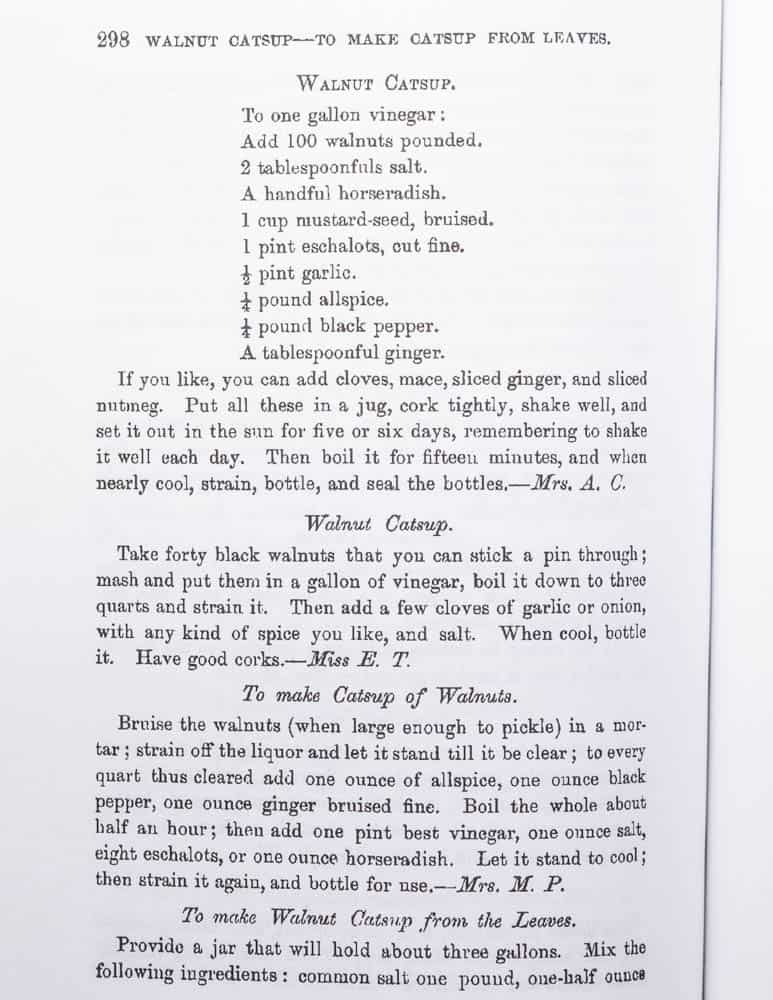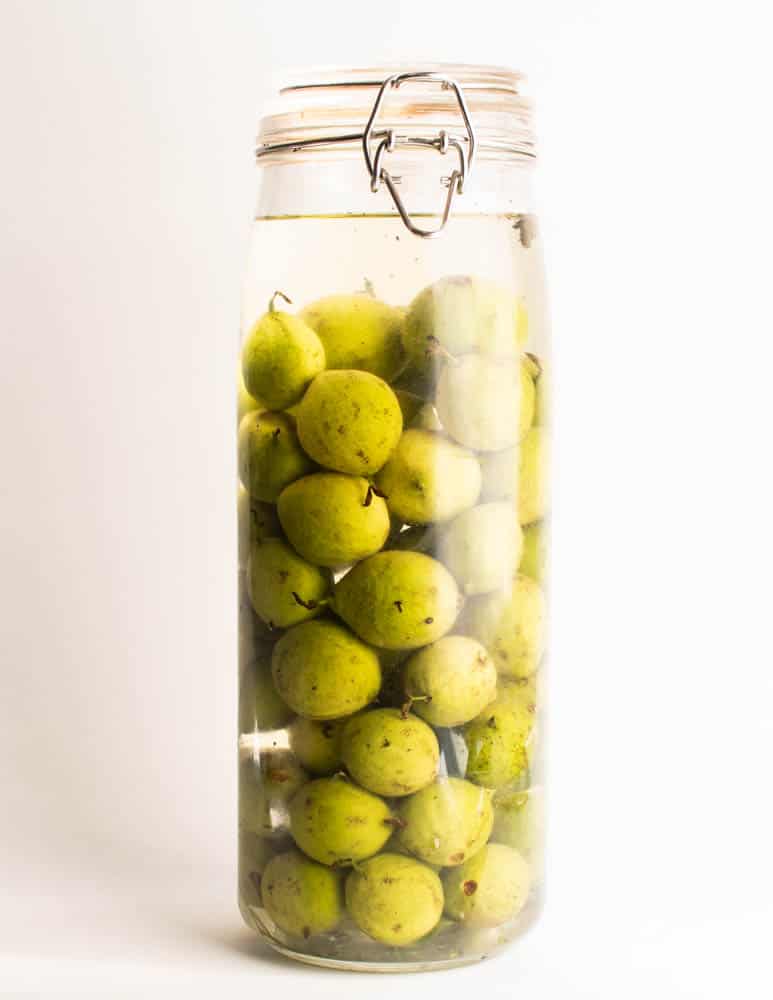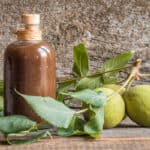Walnut ketchup is an old sauce from a time when the word ketchup or catsup referred to anything but a sauce made from tomatoes. It tastes a bit like steak sauce, but it's made from unripe, green walnuts instead of a mix of spices.

Originally a British recipe, the sauce is still made and sold in bottles to this day, along with other sauces of the same name (mushroom ketchup, for example). Interestingly, I see more recipes for walnut ketchup in books detailing cooking from the 19th century in the United States.
I'd wager that the sauce may have been more popular there that it was originally in Britain, but that's just speculation. One thing that's not up for debate, is that the sauce traveled to the United States through British immigrants.

Given the thrifty nature of the time, It makes sense that the sauce would catch on in North America, as black walnut trees are widespread, and, generally speaking, most people in the United States can probably get access to black walnut trees with a short drive.
Traditional Methods
Like a lot of traditional recipes, there seems to be as many ways to make ketchup from walnuts as there are stars in the sky. Good Housekeeping in Old Virginia, one of my favorite 19th century cookbooks, lists at least 3 or 4, with all of them being very different. Here's some examples.

Looking at the recipes you can see there's some big differences in the way the sauce was made. I've made variations of all of the recipes listed above. The most difficult was by far the third recipe that calls for "bruising the walnuts" and straining off their "liquor".
Let me tell you, there's not a lot of juice in a black walnut, and bruising/crushing them hard enough to remove any liquid at all turns into a black mess that will stain your hands and anything around it for weeks to come.
All of the traditional recipes I've recreated yield a sauce that's thin, and similar to Worcestershire. If that sounds good to you (it is good) make a note to try them.
The recipe I share in this post is thicker, making it easier to use as a sauce for most people. That being said, using some traditional walnut ketchup in places where you'd typically add Worcestershire works well.

Making a modern recipe
The key with this for me was all about finding how to control the extreme tannins of black walnuts, while coaxing out their natural citrus flavor and ending up with a finished product that was jet-black.
Some recipes recommend repeated soaking, and draining (leaching) but this made a final product that lacked color and came out grey-off-green: not attractive.
The soaking leaches out tannins, and is useful, but repeated soaking and draining also leached out the natural citrus flavor of the walnuts I wanted to capture. So, after about 5-6 batches, 500 or so passive hours of work, and a good 120 walnuts, I developed a hybrid method, and it scores high on every note.

In my version the walnuts are soaked, but the water is only discarded at the end of 7 days, so that the citrus aroma continues to penetrate the walnuts as they naturally ferment in the water, but enough soaking liquid is discarded to noticeably soften the tannins we associate so strongly with black walnuts in things like vin de noix and nocino.
To fix the grey-green color, after leaching, the walnuts are left out for 24 hours, which oxidizes and blackens them, which in turn lends the jet hue to the finished sauce.
The end result is a condiment that tastes a bit like black walnuts smell, although the aroma will fade into it’s own thing over time.
The journey to victory, as well as the epic fruit fly battle of emanating from multiple gallon jars of fermenting walnuts, during the peak of summer, was one of the more difficult projects I’ve done.
How to use
Once you've made your sauce, you might wonder what the best ways to use it are. I like to tell people to think of it like steak sauce, but not just for steak. It's a tart, spiced, aromatic condiment you can use in small amounts to spice things up-and you don't have to use it all by itself, especially if you find the flavor a little strong for you. Here's a few ideas.
- Dash some walnut ketchup on top of fried potatoes. I have one friend who even puts it on his potato chips.
- It's a good sauce for proteins, especially beef and pork. Fish can work too, but I like to warm the sauce up a bit and whisk in some butter to smooth it out.
- Dashed on grilled or roasted vegetables.

Black Walnut Ketchup / Catsup
Equipment
- 1 Blender
- 1 Non-reactive container for fermenting like an old glass pickle jar
Ingredients
- 1 lb young black walnuts or butternuts
- 3 cups apple cider vinegar
- 1 cup red wine
- 60 grams 4.5 Tablespoons kosher salt
- 1 oz ¼ cup chopped fresh horseradish
- 1 medium onion (1 cup chopped)
- 1 large clove of garlic, crushed
- 1 oz ¼ cup chopped fresh ginger
- ½ tablespoon each: whole allspice and cloves
- 1 Tablespoon black peppercorns
- 2 oz anchovies in oil, rinsed optional but recommended
- ¼ teaspoon xanthum gum
Instructions
- Soak the walnuts in water for 7 days, without changing the water. The walnuts will ferment naturally. After 7 days, drain the walnuts, crack them, and spread out on a tray until they oxidize and turn black, about 24 hours.
- Toast the peppercorns, allspice and cloves in a pan, then grind to a fine powder.
- Chop the walnuts coarsely, then transfer to a saucepan with the remaining ingredients except the xanthum gum, bring to a simmer and cook for 15 minutes, covered, until the onions are soft. Transfer the mixture to a highspeed blender, puree, strain, then combine with the xanthum gum and puree again to thicken.
- Store the ketchup in a glass jar in the refrigerator. For long term storage, hot pack by pour boiling hot ketchup into a mason jar, screwing on the lid, and turning upside down, allowing to cool and seal. Alternately the ketchup can be canned in mason jars using a water bath.


Elisa Smith
Here’s a picture of the milky globs on the surface of the water with the tiny bubbles: https://share.icloud.com/photos/07cg3Yz3nggFKm3GR-rkyAIrQ
Alan Bergo
Thanks for sending a picture! Those milky globs are bubbles of carbon dioxide, meaning it's fermenting just as it should. This is natural and will ward off mold.
Elisa Smith
Thank you, Alan!
Elisa Smith
Thanks for the amazing post! I had an issue similar to PJ in the comments below. I’m at day 7 of fermenting the unripe black walnuts. They are covered in water in a glass jar with a lid with a water lock.
In addition to tiny bubbles at the surface of the water, I’m seeing a few milky globs. Not sure if this is normal versus a bad sort of contamination?
Alan Bergo
Hi Elisa, there's a lot of environmental / ambient factors that can cause some variation here. You can absolutely just switch the water out for fresh water a few times during the process and it will keep it clean. The soaking here is really to help purge the nuts of tannins-the fermentation won't really have an effect on the finished product.
Heather Johnson
Tried the Walnut Preserves recipe a couple of years ago....amazing! Thank you! I would like to try this ketchup recipe but only collected 1/4 pound of green walnuts this year. Can the recipe ingredients just be adjusted to a quarter of what's called for using a pound of the green walnuts?
Alan Bergo
Hey Heather, generally speaking, yes. It's fine to make a small batch.
Brandon
Hi Alan,
Is it fine to store this in a swing top bottle instead of a jar? If so, how long is the ketchup good for? Thanks.
Alan Bergo
It's good for years. Swing top bottle is fine.
PJ Ray
I'm currently working on this recipe, using green walnuts from a European walnut - instead of the black walnuts you're showing.
However, my green walnuts look kind of funky after the 7 days in water. I took some images: https://i.imgur.com/n1GPIwP.jpeg https://i.imgur.com/rIxc1eC.jpeg https://i.imgur.com/bJmv2OO.jpeg
Does this look correct? They were slowly bubbling over the week (I left my jar slightly open, so it wouldn't have problems with pressure), and there was this odd layer on the surface of the water when I opened them.
They don't smell odd or anything, but some of them turned a bit softer and more brown. I currently have them sitting overnight to darken.
John Paul
Sadly, this recipe did not turn out well for me. The vinegar smell/burn completely over-powered all of the other flavors. I went over the directions and ingredients, and the only thing I didn't follow exactly was with the anchovies. All of my local grocers were out of the cans of fillets (what is going on in my city?) and so I had to settle for anchovy paste. The conversion was 3 Tbsp (a whole tube) equals 2 oz of anchovies. I did see that there was vinegar in the ingredients list, but I think it would be odd to have such a small amount make such a big impact.
Is 3 cups of apple cider vinegar correct? I checked out some other tomato ketchup recipes and most use between 1/2 and 3/4 cup vinegar for 3 cups of sauce.
Alan Bergo
John, this sauce is nothing like tomato ketchup, think more along the lines of steak sauce, but looser and more potent. Ketsiap is a Vietnamese word that American ketchup is derived from and the product is similar to fish sauce--nothing even close to tomato ketchup. You'd want to compare my recipe with other recipes for walnut ketchup if you want some baseline ratios to compare. The sauce also improves over time as it sits, as does everything made from green walnuts. If you haven't made strong, potent sauces like this, the flavor, especially at first before it has time to mellow and soften over time, is powerful. Forget about the jar for a month or so, then try dashing it on roasted potatoes or vegetables or other mild tasting things.
John Paul
Oh, that's great to know, thanks. I'll take another taste in a month or two.
John Paul
When it comes time to spread the walnuts out on a tray to oxidize, should they be left out at room temperature or refrigerated?
Alan Bergo
Room temp is all I’ve ever done but you could put them in the fridge too.
Richard Stevens
I made this and substituted miso for anchovies. It was amazing! Best 'steak sauce' you will ever eat.
Alan Bergo
Hey Richard, Nice move substituting miso for anchovies, great hack there.
Bill Fowler
Are you using the entire walnut: hull shells and whatever little nut may be in a immature walnut?
Alan Bergo
Yes, please refer to my article on green walnuts. The entire thing, green hull and all is used. This is a very traditional recipe.
K-A
I tried this recipe and I'm not sure I was successful. When you say "puree, then strain" can you expand on that? How much liquid to strain? Do I throw out the liquid?
Alan Bergo
You puree it in a blender, then strain it. The solids are discarded, the liquid is the ketchup.
Ian Campbell
Excellent tasting sauce! The only modification I made was that when weighing the salt on my scale, 60 grams translated to about 3 tablespoons, so I went with that amount instead of the 4.5. Sadly I haven’t had anything to put it on yet. I have had it stored in my refrigerator for a few days but I think I want to jar most of it. Can I bring it to a boil again and then immediately pour it into hot, sterilized jars and invert? Do I have to boil it again for a certain duration? Or is reboiling it now a bad idea since the xanthum gum is already in the mixture?
Also, is there any reason that the solids, once strained out, couldn’t be dehydrated and grinder for a spice- similar to what is done with the solids from mushroom catsup? I did this but haven’t tried it yet as a spice!
Alan Bergo
Hey glad you liked it. Drying the solids isn’t something I would do. Not a lot of flavor in the leftovers, compared to seasonings I dry like ramp salt. I discard the solids and thank them for their service.
Taija
Hi Alon,
I am confused, in Switzerland we got walnut, I am just aware from one species…
You are talking about green and black walnut.
Is this the same tree? If so I understand and waiting for Saint John’s Eve.
For us the traditionell day to harvest “ green walnut” .
Greetings Taija
Alan Bergo
Taija,
The only walnuts I’m speaking about here are Juglans nigra. When they’re green, they’re referred to as green walnuts, or unripe walnuts. Technically you could also call them green black walnuts. Does that make sense?
Katie B
I would like to try canning this, using hot water method.
I am wondering if you know how long it needs to be in the water bath for.
I have a tiny fridge and a huge walnut tree, plus many in my area (thank you squirrels) and want to make a large batch to share. I think I need to preserve it in jars. Thank you for any help on this, and for sharing your recipe.
Alan Bergo
It needs to be in the water bath for whatever the recommended time is for pickling the size of jars you're using.